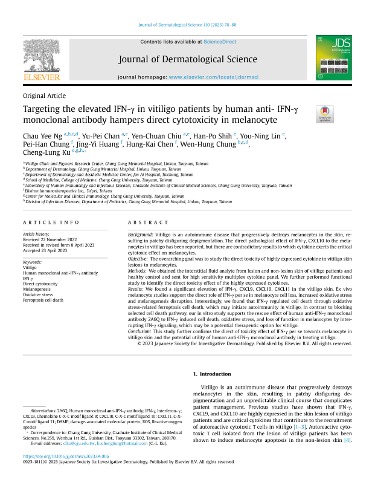Publications
- Home
- Publications
- Research Publications
- Targeting the elevated IFN - γ in vitiligo patients by human anti - IFN - γ monoclonal antibody hampers direct cytotoxicity in melanocyte
Targeting the elevated IFN - γ in vitiligo patients by human anti - IFN - γ monoclonal antibody hampers direct cytotoxicity in melanocyte

Abstract:
Vitiligo is an autoimmune disease that progressively destroys melanocytes in theskin, resulting in patchy disfiguringdepigmentation. The direct pathologicaleffect of IFN-γ,CXCL10 to the melanocytesin vitiligo has been reported, but there arecontradictory results to which cytokineexerts the critical cytotoxic effect onmelanocytes.We obtained the interstitial fluid analytefrom lesion and non-lesion skin of vitiligopatients and healthy control and sent forhigh sensitivity multiplex cytokine panel. Wefurther performed functional study toidentify the direct toxicity effect of the highlyexpressed cytokines.We found a significant elevation of IFN-γ,CXCL9, CXCL10, CXCL11 in the vitiligoskin. Ex vivo melanocyte studies supportthe directrole of IFN-γper se in melanocytecell loss, increased oxidative stress andmelanogenesis disruption. Interestingly, wefound that IFN-γregulated cell deaththrough oxidative stress-related ferroptosiscell death, which may initiate autoimmunityin vitiligo. In contrast to blocking selectedcell death pathway, our in vitro studysupports the rescue effect of human anti-IFN-γmonoclonal antibody 2A6Q to IFN-γinduced cell death, oxidative stress, andloss of function in melanocytes byinterrupting IFN-γsignaling, which may bea potential therapeutic option for vitiligo.FAQ Classification
Related FAQ
- A comparative study of an advanced skin imaging system in diagnosing facial pigmentary and inflammatory conditions
- From zero to one: Recent advances in the pathogenesis, diagnosis, and treatment of vitiligo.
- Skin Interstitial Fluid and Plasma Multiplex Cytokine Analysis Reveals IFN-γ Signatures and Granzyme B as Useful Biomarker for Activity, Severity and Prognosis Assessment in Vitiligo
- Pathogenic autoantibodies to IFN-γ act through the impedance of receptor assembly and Fc-mediated response
- Feasibility of Oral Tranexamic acid (TA) for Vitiligo Patients with Melasma
- A comparative study of suction blister epidermal grafting and automated blister epidermal micrograft in stable vitiligo
- Efficacy and safety of automated epidermal micrograft in patients with stable segmental and nonsegmental vitiligo
- Feasibility of High-Cellular-Resolution Full-Field, Artificial-Intelligence-Assisted, Real-Time Optical Coherence Tomography in the Evaluation of Vitiligo: A Prospective Longitudinal Follow-Up Study.
- Association of multiple sclerosis with vitiligo: a systematic review and meta- analysis
- Vitiligo associated with polycaprolactone-based collagen stimulator filler

